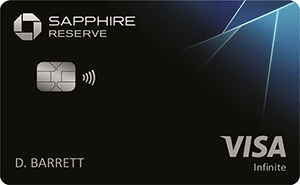7 Things to Know Before Getting the Chase Sapphire Preferred
Consider factors like your credit score, travel plans and the Chase 5/24 rule before applying.

Many or all of the products on this page are from partners who compensate us when you click to or take an action on their website, but this does not influence our evaluations or ratings. Our opinions are our own.
The Chase Sapphire Preferred® Card has long been a popular choice for both newbie and advanced travel credit card aficionados alike. The card has a slew of spending category bonuses, including 5x total points on all travel booked through Chase, 3x points on dining (including qualified delivery services, takeout and dining out — up from 2x points) and 3x points on some streaming services.
Throw in the card’s relatively low annual fee of $95, the 25% boost in value for points redeemed for travel through Chase, the ability to transfer points to Chase's travel partners and other benefits like travel insurance, and it’s easy to see why people love this card.
Right out the gate, new cardholders can also earn the card's current sign-up bonus offer: Earn 100,000 bonus points after you spend $5,000 on purchases in the first 3 months from account opening.
Here are seven things to consider before submitting your application.
1. Your credit score
The Chase Sapphire Preferred® Card isn’t a credit card for everyone — you’ll need to have good to excellent credit to have a chance at getting approved.
We recommend having a FICO score of at least 690 before applying for this card. If you need to wait a bit and work on your credit, it’s a good idea to do that. Here are the best starter cards NerdWallet recommends.
2. Your Chase 5/24 count
You won’t be able to get this card if you’re not under Chase’s unpublished (but widely known) 5/24 rule. That means if you’ve opened five or more credit cards in the last 24 months (from any bank), your chances for approval are slim to none.
» Learn more: The best Chase credit cards right now
3. The annual fee
Though not as high as the $500+ annual fees you can expect from premium travel credit cards, the Chase Sapphire Preferred® Card still has an annual fee of $95. You'll have to consider whether this annual fee fits into your budget, especially considering any other annual fees you are already paying with your existing cards.
It can be easy to recoup a large portion of the annual fee through the annual $50 credit on hotels booked through Chase.
Also, consider the value of the points you'll earn on the card all year. Let's say you spend about $1,300 per year on dining and streaming services. Those categories earn 3x points, so you'll earn 3,600 Chase Ultimate Rewards points® per year on the card. As a holder of the Chase Sapphire Preferred® Card, you can redeem those 3,600 points for travel booked through Chase's portal at a rate of 1.25 cents apiece. That travel redemption is worth $45 in cash, which also makes up for a portion of the annual fee.

Still, if you don’t use the card often — particularly when it comes to the bonus categories — or you don't travel at least once per year, you might be better off with a no-annual-fee travel credit card.
» Learn more: Is the Chase Sapphire Preferred® Card worth its annual fee?4. Your eligibility for the welcome bonus
Chase has put rules in place to limit eligibility for their bigger welcome bonuses. You can only collect bonus points on Sapphire-branded Chase credit cards every 48 months. That means if you’ve received bonus points from the Chase Sapphire Reserve® within the last 48 months, you’ll need to wait.
Also, if you now have the Chase Sapphire Reserve® and you were to downgrade your card to a Chase Sapphire Preferred® Card, you wouldn’t qualify for the bonus points.
» Learn more: The best travel credit card sign-up bonuses right now
5. Your current Sapphire situation
Cardmembers are only able to have one Sapphire branded card at once. That means if you have a Chase Sapphire Reserve® already, you’ll need to wait until you cancel or downgrade it to a no-fee card to apply for the Chase Sapphire Preferred® Card.
However, considering No. 3 above, there’s really no sense in applying for the Chase Sapphire Preferred® Card if you can’t get a nice welcome bonus — which means you would want to wait 48 months before applying.
on Chase's website
on Chase's website
Earn 100,000 bonus points after you spend $5,000 on purchases in the first 3 months from account opening.
Earn 60,000 bonus points after you spend $5,000 on purchases in the first 3 months from account opening.
5 points per $1 spent on all travel booked through Chase.
3 points per $1 spent on dining (including eligible delivery services and takeout).
3 points per $1 spent on select streaming services.
3 points per $1 spent on online grocery purchases (not including Target, Walmart and wholesale clubs).
2 points per $1 spent on travel not booked through Chase.
1 point per $1 spent on other purchases.
Through March 2025: 5 points per $1 spent on Lyft.
Points are worth 1.25 cents apiece when redeemed for travel through Chase.
10 points per $1 spent on Chase Dining purchases.
10 points per $1 spent on hotel stays and car rentals booked through Chase.
5 points per $1 spent on air travel booked through Chase.
3 points per $1 spent on travel and dining not booked with Chase.
1 point per $1 spent on other purchases.
Through March 2025: 10 points per $1 spent on Lyft.
Points are worth 1.5 cents apiece when redeemed for travel through Chase.
A $50 annual credit on hotel stays booked through Chase.
Each account anniversary, cardmembers will earn bonus points equal to 10% of total purchases made the previous year.
1:1 transfer partners, including United, Southwest, JetBlue, Marriott and Hyatt.
$300 annual credit, automatically applied to travel spending.
1:1 transfer partners (same as the Chase Sapphire Preferred® Card).
Access to more than 1,000 airport lounges worldwide through Priority Pass Select.
Statement credit once every four years for NEXUS, Global Entry or TSA PreCheck application fee charged to your card.
Access to “Reserved by Sapphire” restaurant-booking feature.
» Learn more: Chase Sapphire showdown: Reserve vs. Preferred
6. Your spending plans
Before applying for the Chase Sapphire Preferred® Card, you want to think about your spending plans for the next few months. Make sure you can meet the minimum spend to actually receive your bonus points. For instance, if you’re planning to book a lot of travel or even have some home improvement projects to do, it might be easier to meet the minimum spend than if you’re trying to conquer a no-spend month.
Ideally, a good chunk of your spending falls within the card’s bonus categories. Those are:
5x total points on all travel booked through Chase.
5x points on Lyft rides through March 2025 (that's 3x points plus the 2x points you already earn on travel).
3x points on dining, including eligible delivery services, takeout and dining out,
3x points on some streaming services.
3x points on online grocery purchases (except Target, Walmart and wholesale clubs).
2x points on travel booked outside of Chase.
You earn 1 point per $1 spent on all other purchases.
» Learn more: The best benefits of the Chase Sapphire Preferred® Card
7. How often you'll travel
Before applying for the Chase Sapphire Preferred® Card, consider your travel preferences and habits. If you want complimentary airport lounge access or credit toward your TSA PreCheck fees, you'll need a more premium credit card, like the Chase Sapphire Reserve®.
While it commands a higher annual fee, it also comes loaded with a significantly higher earning rate: 10x total points on hotel stays and car rentals purchased through Chase and 5x total points on air travel booked through Chase.
Some Chase Sapphire Reserve® travel benefits that the Chase Sapphire Preferred® Card doesn't have:
A free Global Entry, NEXUS or TSA PreCheck credit.
Complimentary airport lounge access into Priority Pass lounges and Chase’s own airport lounge brand (Chase Sapphire Lounge by The Club).
A $300 annual travel credit.
A 1.5 cents per point redemption rate when booking through Chase's travel portal.
Another travel aspect to consider is whether you are likely to fly or stay with any of Chase's transfer partners.
If you usually stay at Hilton properties, for example, and want the ability to transfer credit card points to Hilton, you'd likely be better off with a card from a different issuer that is a transfer partner of Hilton.
» Learn more: The best travel credit cards
If you're considering the Chase Sapphire Preferred® Card
The Chase Sapphire Preferred® Card can be a useful travel credit card to have if want one with a low annual fee and you want to redeem at least some of your rewards for travel. Just be sure your ducks are all in a row when it comes to your credit score, 5/24 count and bonus eligibility.
And as always, make sure you have a logical plan in terms of how to hit your spending bonus and how to make the most of the card's ongoing perks.
How to maximize your rewards
You want a travel credit card that prioritizes what’s important to you. Here are some of the best travel credit cards of 2025:
Flexibility, point transfers and a large bonus: Chase Sapphire Preferred® Card
No annual fee: Wells Fargo Autograph® Card
Flat-rate travel rewards: Capital One Venture Rewards Credit Card
Bonus travel rewards and high-end perks: Chase Sapphire Reserve®
Luxury perks: The Platinum Card® from American Express
Business travelers: Ink Business Preferred® Credit Card
Chase Sapphire Preferred® Card
Travel
Dining
🔥 Huge highest-ever bonus on NerdWallet's 2025 Best All-Purpose Travel Rewards Card is back. Don't miss your rare chance to: Earn 100,000 points when you spend $5,000 on purchases in the first three months. That's worth at least $1,250 toward travel booked through Chase.





